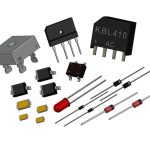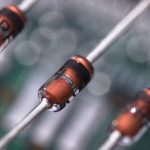Today the markets of digital communication signal processing equipment and other portable devices has the need of developing a large number of small size electronic components. The integration of multiple functions and miniaturization of electronic components on the boards due to constraints on the board space provides the requirement of other packaging technologies.
Signal diodes are used in switching operations, snubbing circuits on which short duration waveforms are concentrated, high speed data lines and other I/O parallel connected ports. These signal diodes have enormous applications in signal processing and digital communications. There is a series of signal diodes available in the market. Of them, 1N4148 series signal diode is widely used in a large number of electronic circuits due to its small size, power requirements and other useful parameters. In the following diagram pin 5 is used for ground.
To combat the over space requirement on digital circuit boards, signal diodes are connected in parallel configuration forming an array called as small signal diode arrays. They are enclosed in a plastic case or glass case in single line or dual line packages, features from 4 to 14 diodes to provide common cathode or common anode configurations.

The space saving signal diode array configurations provide electro static discharge protection, heat control and over voltage transients. These advantages make the diode arrays, ideal to be placed in the circuits on PCBs.
When the signal diodes are connected in series with the respective power supply terminals, then the data lines that are connected at the junction between the two signal diodes are protected from unnecessary transients and thereby the data will continue to pass along the data lines. If the signal diodes are connected in 6-fold, then the array can guard all the 6 data signal lines in a single inline package. Signal diode arrays can be used for regulating the voltage that is applied to circuit on the PCBs. If the voltage applied exceeds the maximum voltage rating, then the excess energy provided will be penetrated as heat which may damage the device.

Signal Diodes in Series:
In order to protect the board from excess voltages the signal diodes can be connected either in series or in parallel configurations for providing the fixed known voltage within the limit. When the signal diodes are connected in series the maximum current required by the diodes in the array is same and the maximum voltage drop in the array will be the sum of all the forward voltage drops in the array of signal diodes.
In the array of signal diodes in series configuration, the output voltage will be constant in spite of variations in the current in the load connected or in the variations of the input voltage applied. Hence supply of constant voltage is provided by the signal diode series combination.
Since the forward voltage drop of silicon diode is 0.7 V and the current through the silicon diode alters by a fairly large number, the signal diode connected in forward bias will make a circuit of the simple voltage regulator. The individual forward voltage drop of each signal diode in series combination is thus subtracted from the input voltage applied to depart a certain amount of voltage across the load resistor connected at the end of the circuit. This is due to ON resistance of each diode in addition to the load resistance R. With the addition of a number of signal diodes in series, a large amount of declination in voltage will takes place. Furthermore the signal diodes connected in series, in parallel with the load resistor R act as a voltage regulator circuit.



